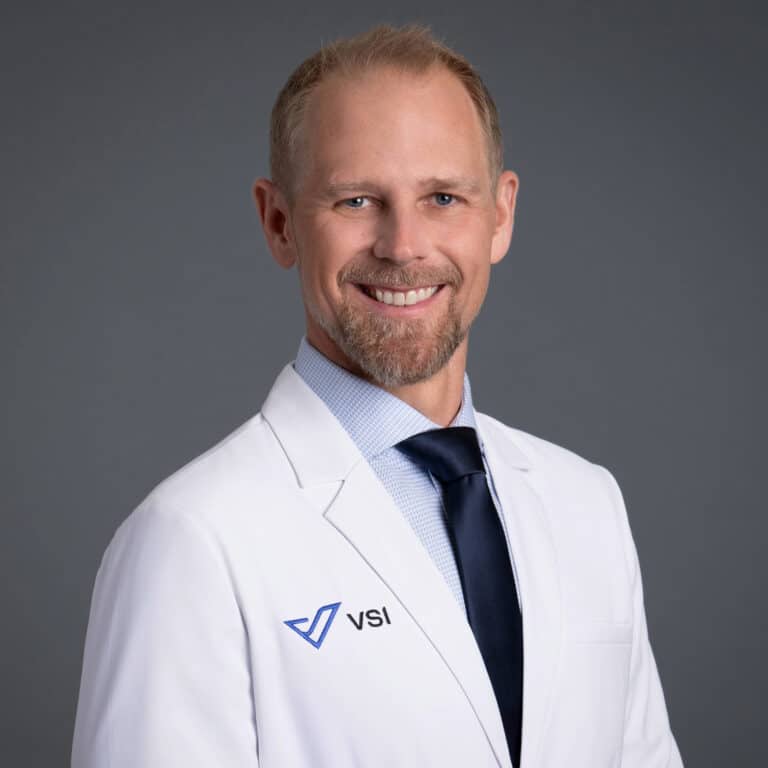
Dr. Good Performs 1st Augmented Reality Spinal Surgery in Virginia and DC Region
VIRGINIA SPINE SURGEON PERFORMS 1ST AUGMENTED REALITY SPINAL SURGERY IN VIRGINIA AND DC REGION
Spine surgeon Christopher Good used augmented reality technology to perform lumbar fusion with new technology that essentially gives surgeons ‘x-ray vision’ during complex procedures.
RESTON, VA – October 9, 2020 – One week out from World Spine Day, VSI (Virginia Spine Institute) spine surgeon, Dr. Christopher Good becomes the first in the Virginia and Washington, D.C. area to use augmented reality (AR) technology for surgery.
Thursday, October 8, 2020 Dr. Good used the groundbreaking technology to perform a lumbar fusion surgery on a 43-year-old male patient. The AR “Xvision”system, made by Augmedics, makes it possible for surgeons to visualize a patient’s 3D spinal anatomy during surgery – almost like they have ‘x-ray vision.’ This groundbreaking new technology is the first application of augmented reality in surgery and has the potential to streamline and partner several technologies in the operating room, giving surgeons better control and making procedures easier, safer, faster and less invasive. The surgery was performed at Reston Hospital Center (HCA Virginia Health System).
Approved by the FDA this past December, AR has been shown to improve accuracy, potentially leading to better patient outcomes. It’s expected to revolutionize the healthcare industry leading to faster, safer surgical procedures.
The technology utilizes all elements of a traditional navigation system, including a special headset the surgeon wears during the procedure. The navigation system projects the patient’s CT images into the surgeon’s headset, making it possible for him to see high-resolution 3D pictures inside the bones of the patient’s spine superimposed over the patient’s actual anatomy in real time. The goggle headset also accurately determines the position of surgical tools and superimposes them on the patient’s vital data, so the doctor never has to take his eyes off the patient.
“This is the first utilization of augmented reality in the field of surgery and it’s a game changer. This technology allows us to have a patient’s information and scans in front of us in a customizable display so instead of just looking at the surface of the bone, I can literally see the 3D picture inside as well as a computerized target drawn on the bone showing where I need to go,” Dr. Good explains. “This means I never have to look away from the patient at scans on a screen across the operating room and I can stay focused entirely on the patient while operating on them. It’s as if I had x-ray vision!”
The patient, Trent Pederson, flew in from Minnesota to have this procedure with Dr. Good to address severe spinal stenosis and progressive nerve damage. “I’m honored to be able to be a part of this,” Pederson says. “I have 100 percent confidence in the capabilities of Dr. Good and his team and to be part of this groundbreaking procedure that is taking medicine and surgeries to the next level is great. I’m humbly honored to be a part of it and I have no qualms or issues with being one of the first to ever have this done. I think that’s actually pretty cool.”
Dr. Good says this technology holds infinite promise in surgery, provides an enhanced view of the narrow channels spinal surgeons work in and will even allow surgeons to do some procedures in a less invasive way because the AR scans will reduce the need for incisions in some situations. “It will be especially helpful when people have had previous surgery because there is abnormal anatomy and we will actually be able make adjustments very easily as we are navigating during surgery,” Dr. Good explains.
“We’re extremely excited to be involved in developing this groundbreaking technology and thank Trent for being a pioneer in wanting to incorporate this technology into his surgery,” Dr. Good says. “We are excited to be able to offer this technology to other patients too. Bringing AR into the operating room has the possibility of leading to smaller incisions and less invasive procedures which means less pain and faster recovery for patients.”
Topics covered
About the Author
Featured Resources
Insights to Achieve a Pain-Free Life



